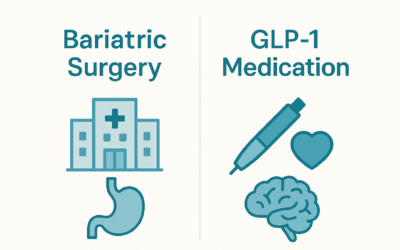There’s a lot of buzz right now around the weight loss/diabetes drugs tirzepatide and Mounjaro. Is one better than the other for weight loss? Which one should you choose? Does it make a difference?
At first glance, these two medications seem identical — after all, Mounjaro is simply the brand-name version of tirzepatide. But when you dig a little deeper, things get slightly more complicated.
If you’re trying to decide between the two, the real question isn’t just about what they are, but about how they fit into your life. Are you looking for an option that’s more affordable? Do you need flexibility with dosing? Will insurance play a role in your decision? These factors can make all the difference in your long-term success.
So before you choose between tirzepatide vs. Mounjaro, here are X key questions you need to ask yourself.
1. Tirzepatide vs. Mounjaro: Are they really the same?
Yes and no. Mounjaro is tirzepatide, just with a cool-sounding brand name — and a much higher price tag. Think of it like buying a name-brand pain reliever (like Advil) versus the generic version (store-brand ibuprofen). The active ingredient is identical, meaning the way the drug works in your body and the results you get should be exactly the same.
Tirzepatide (the drug itself) belongs to a class of medications that mimic two key hormones—GLP-1 and GIP. These hormones help regulate blood sugar, slow down digestion, and reduce hunger, which is why people taking tirzepatide for weight loss often find it much easier to eat less and lose weight.
So if Mounjaro and tirzepatide are the same medication, why does the choice matter? Because how you get them is different. Mounjaro is the FDA-approved, mass-produced version that comes in fixed doses. Compounded tirzepatide, on the other hand, is made by specialized pharmacies that mix the medication themselves. This means doses can be customized to better fit your needs, which isn’t an option with brand-name Mounjaro.
If you’re someone who prefers a one-size-fits-all approach and insurance is covering the cost, Mounjaro might be the easier choice. But if affordability, flexibility, and availability matter to you, compounded tirzepatide might be worth a closer look.
2. Tirzepatide vs. Mounjaro: Does one work better for weight loss?
If they’re the same drug, does that mean they deliver the same results? In theory, yes. Since both Mounjaro and compounded tirzepatide contain the exact same active ingredient, the way they affect your body should be identical. But in practice, there are a few things that might make a difference in how much weight you lose—and how quickly you lose it.
One factor is dosing. Mounjaro is only available in specific, pre-set doses, which means you have to follow a fixed schedule when increasing or adjusting your medication. Compounded tirzepatide, on the other hand, offers more flexibility. If you need a slower dose increase to manage side effects or a more gradual taper to find your ideal maintenance dose, a compounding pharmacy can adjust it to fit your needs.
Another consideration is consistency. Because of high demand and ongoing shortages, people taking Mounjaro may find themselves stuck waiting for refills or forced to switch to a different dose when their usual one isn’t available. That’s a problem when you’re relying on the medication to curb hunger and support weight loss. Compounded tirzepatide, on the other hand, isn’t subject to the same supply-chain issues, making it a more reliable option for people who don’t want interruptions in their treatment.
So, in a head-to-head comparison of tirzepatide vs. Mounjaro, the medication itself works the same—but your access to it, the ability to fine-tune your dose, and the consistency of treatment can make a difference in your overall results.
3. Tirzepatide vs. Mounjaro: Which one is more affordable?
If cost weren’t a factor, choosing between tirzepatide vs. Mounjaro would be easy. But for most people, price matters—a lot. And when you’re looking at a medication that you may need to take for months (or even years) to maintain results, the difference in cost adds up fast.
Mounjaro, as the brand-name version, comes with a brand-name price tag. Without insurance, it costs well over $1,000 a month. If you have type 2 diabetes, your insurance might cover it — but if you’re taking it for weight loss, that coverage becomes a lot less certain. Many insurance plans won’t pay for Mounjaro unless you meet specific criteria, which means plenty of people are stuck paying out of pocket.
Compounded tirzepatide, on the other hand, is far more affordable. Because it’s made by licensed compounding pharmacies rather than a single pharmaceutical company, it isn’t tied to the same inflated pricing. While exact costs vary, compounded tirzepatide often runs 50–70% less than Mounjaro—which means you can stay on it longer without breaking the bank.
Of course, insurance typically won’t cover compounded medications either, so you’ll still be paying out of pocket. But the real question isn’t just about whether you can afford a medication for a month — it’s whether you can afford to stay on it long enough to actually reach your weight-loss goals. And for a lot of people, that makes all the difference.
4. Tirzepatide vs. Mounjaro: Will insurance cover it?
For many people, the biggest deciding factor in the tirzepatide vs. Mounjaro debate isn’t which one works better — it’s which one their insurance will actually pay for. And unfortunately, getting coverage for these medications isn’t always straightforward.
Mounjaro is only FDA-approved for type 2 diabetes, which means insurance companies are more likely to cover it for people with diabetes. But if you’re taking it for weight loss, you could run into roadblocks. Some plans won’t cover it at all, while others require proof that you’ve met specific criteria — like having a certain BMI or failing to lose weight through diet and exercise alone. Even if you do qualify, coverage isn’t guaranteed forever. Some insurers will cut off coverage after a certain period, forcing patients to either pay out of pocket or stop treatment altogether.
Compounded tirzepatide, on the other hand, is rarely covered by insurance. But don’t worry; that doesn’t mean it’s unaffordable. Since compounded medications aren’t FDA-approved in the same way brand-name drugs are, most insurance companies won’t reimburse the cost. That means if you go this route, you’ll likely be paying out of pocket—but it also means you won’t be paying the exhorbitant price tag that goes along with the brand name Mounjaro.
So, which one is the better deal? If your insurance covers Mounjaro, it might be the more affordable option — at least in the short term. But if you’re paying cash, compounded tirzepatide is usually the clear winner, offering the same medication at a fraction of the cost.
5. Tirzepatide vs. Mounjaro: What about availability and shortages?
Even if you can afford Mounjaro’s price tag — can you actually get it? That’s a whole different question. Since it hit the market, Mounjaro has been in high demand — so much so that shortages have become a recurring problem. Many patients have run into delays, pharmacy backorders, or have even been forced to pause their medication because they couldn’t get their usual dose.
And that’s a bigger deal than it sounds like. When you’re using tirzepatide to regulate hunger and support weight loss, consistency matters. Gaps in treatment can throw everything off, from your appetite to your progress on the scale. Having to switch doses or stop entirely because of supply issues isn’t just frustrating — it can set you back weeks or months.
Compounded tirzepatide, on the other hand, doesn’t rely on a single manufacturer’s production schedule. Because compounding pharmacies source pharmaceutical-grade tirzepatide separately and prepare medications in-house, they don’t get hit with the same supply chain bottlenecks. That means even when Mounjaro is out of stock, compounded tirzepatide is often still available — allowing you to continue treatment without unexpected interruptions.
So if you’re weighing tirzepatide vs. Mounjaro, don’t just think about which one your insurance might cover or which has a recognizable name. Think about whether you’ll actually be able to get the medication when you need it. Because the best weight-loss drug in the world won’t help you if you can’t get your hands on it.
Tirzepatide vs. Mounjaro: Which one fits your life?
With compounded tirzepatide being both cheaper and easier to get, you might be wondering — why would anyone still choose Mounjaro? As it turns out, there are a few solid reasons depending on your circumstances.
First, some people just feel more comfortable with an FDA-approved, brand-name drug. Mounjaro is the version that went through large-scale clinical trials, and for some, that stamp of approval offers peace of mind — even though the active ingredient is exactly the same.
Then there’s insurance. If you’re one of the rare few whose plan actually covers Mounjaro for weight loss (which isn’t common, since it’s technically only FDA-approved for diabetes), your out-of-pocket cost might be lower than paying cash for compounded tirzepatide. That said, insurance coverage can be unpredictable — what’s covered today might not be covered tomorrow.
And finally, some doctors just won’t prescribe compounded medications. Whether it’s unfamiliarity, a preference for FDA-approved options, or simply not wanting to deal with the logistics, some providers stick to the brand name by default.
So, in the debate of tirzepatide vs. Mounjaro, compounded tirzepatide makes sense for most people. But if insurance covers Mounjaro, your doctor won’t prescribe compounded alternatives, or you just prefer the security of a name-brand medication, Mounjaro might still be the better fit for you.
At the end of the day, the decision between tirzepatide vs. Mounjaro isn’t about which drug works better — it’s about which option makes the most sense for you and your life.
Both medications are identical in terms of effectiveness, but the real differences come down to cost, availability, flexibility, and insurance coverage. If you’re lucky enough to have insurance that covers Mounjaro, it might be the easier option. But for everyone else, compounded tirzepatide offers a more affordable, more customizable, and more accessible alternative.
In the long run, the best weight-loss medication isn’t the one with the biggest brand name — it’s the one you can actually afford to stay on long enough to reach your goals. And if cost and availability are your deciding factors, the choice might already be made for you.
Ready to take the next step? Learn more about Claya’s weight-loss treatment programs for medically supervised weight loss.



